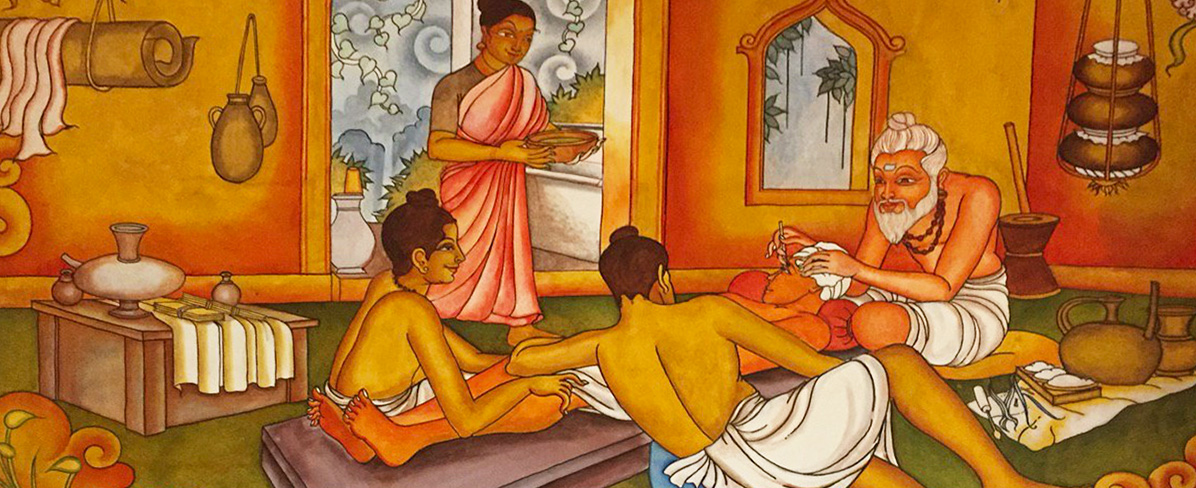Health & Illness in Ayurveda
Health in Ayurveda is not simply the absence of disease, but according to Suśruta Saṃhita, one of the essential textbooks of Ayurveda, health is defined as follows:
samadoṣaḥ samāgniś ca samadhātumalakriyaḥ ||
prasannātmendriyamanāḥ svastha ity abhidhīyate ||
Suśruta Saṃhita, Sūtrasthāna, 15.41
The person whose doshas are in balance, whose agni is balanced, whose tissues are properly formed, whose excretions function normally, whose soul, mind and senses are filled with happiness and who rests in the Self is called healthy.
Due to the manifold and extremely fine diagnostic methods of Ayurveda, imbalances, which under certain circumstances can develop into serious diseases, can be detected before one notices any signs of them oneself.
Ayurveda divides the development of a disease into six stages.
- sañcaya – accumulation, that is, a dosha – Vata, Pitta or Kapha – begins to accumulate in its own area. Possible symptoms are mild and appear only sporadically. For accumulating Vata, these may include flatulence or constipation, slightly increased Pitta heat sensation or dark yellow discoloured urine, and cumulative Kapha feeling of fullness and lethargy.
- prakopa – irritation, aggravation. A dosha continues to rise, but remains in its original place. Symptoms observed in this phase may include with increasing Vata bowel sounds or excessive peristalsis, with Pitta heartburn or acid stomach discomfort and with Kapha mucus..
- prasara – propagation. In this phase the doshas leave their natural areas and move to other places in the body where they can spread. For example, Vata can leave the large intestine and spread to the skin, ears or bones. Symptoms include dry skin, cold hands and feet, and ringing in the ears.
When Pitta leaves its original site in the small intestine, it can spread to the stomach, eyes or sweat glands. Possible symptoms are heartburn, burning eyes or sour-smelling sweat.
If Kapha leaves its area in the upper stomach and chest and spreads to the head or lymphatic system, water retention in the tissues or blocked sinuses can be possible symptoms - sthāna saṁśraya – deposition or localization. The significantly increased dosha settles in a place that does not belong to its original area. This happens because the dosha has an affinity to this new place or because there is a weakness or a defect due to genetic predisposition, previous trauma, increased emotional stress or suppressed emotions. The dosha penetrates the tissue of the new place with its own qualities, increases there and can change the normal qualities of the tissue. Preliminary signs of illness now appear, which can already be recognized as such by an experienced physician (even a western physician).
- vyakti – manifestation. The dosha has overcome the tissue of the new place and the qualities of the foreign dosha now manifest in the tissue by suppressing the natural qualities of this dhatus. A disease with its specific symptoms, as we know them in the Western understanding, comes to manifest.
- bheda – complication. At this stage, structural changes in the tissues and organs/organ systems manifest themselves and complications arise. It is the final stage of the course of a disease. In the fifth stage of a disease development the function of a tissue or organ is disturbed. In the sixth and final stage of the disease the tissue structure is changed and the function of the surrounding tissues and organs is disturbed. Treatment in this stage is extremely difficult or impossible.
Every science has its limits in certain areas. According to Ayurveda, diseases are differentiated in sādhya (curable) and asādhya (not curable). A finer subdivision is made into: sukha sādhya (easily curable), kṛcchra sādhya (difficult to cure) as well as yāpya (manageable) and kṛcchra/anupakrāmya (not curable/not treatable). Taking these factors into account, it must be stated that Ayurveda cannot cure all the diseases of mankind.


